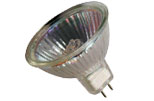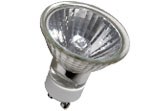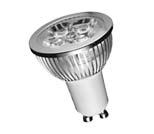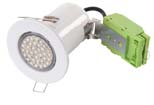Downlights can help make a clutter-free environment and a sense of space
Installing recessed downlights in a room can help to create a feeling of more space, clean lines, and a clutter-free environment.
A downlight is a light fitting that is mostly out of sight, hidden in or above the ceiling. The only visible part of the light fitting is the decorative rim, and the light bulb in the middle. Everything else is held in place in the ceiling by spring clips that stop the whole thing giving in to gravity and falling out.
Downlighters, especially in kitchens and bathrooms have become very popular, as they provide a modern appearance to the room. More recently the trend has spread to every other room. Lounges, bedrooms and hallways all look great when fitted with recessed downlighters.
What to consider...
Power usage - downlights can use a lot of power. When specifying which lights to install, make sure that you know how much power they will use once the job is finished. Remember, it's the watts that count, not the volts - we have written another article about the difference between low voltage and low energy lighting products.

A narrow beam angle can be used for lighting specific objects areas or areas
Beam angle - unless you are intending to create a special effect (such as lighting individual tables in a restaurant) you should always try to install the widest beam angle that you can. This refers to how far the light will spread from each downlight unit. A narrow beam angle will produce a small pool of light, and a wide beam angle will spread the light further which reduces any dark spots that you might have between fittings.
Building regulations - If you're building a new property or renovating an existing one there might be various rules and regulations that you must comply with. Regulations cover all sorts of things, from how much sound travels through a downlight, how draught-proof they are, to how long they will prevent a fire from spreading to the room above, to how efficient they are (i.e. how much light is produced from the power used).
All of these requirements can generally be met by installing fire rated downlights.
Different types of downlights
There are three main types of downlight product that you should consider, each with its own advantages and disadvantages:
Low voltage downlights

Low voltage downlights
require a transformer
Low voltage downlights run at 12 volts rather than at the mains voltage of 230v. This introduces the first problem - to reduce the voltage you need a transformer. A transformer is an extra piece of equipment that could fail and might introduce unnecessary cost. You must also make sure that the transformer you use is capable of running the number of lights you wish to install. You have to match up the wattages, e.g. if you want to install 9 x 50w bulbs, you will need a transformer capable of running 450 watts, or 2 transformers with at least 225 watts each.
Most modern low voltage lighting transformers are suitable for use with dimmer switches, but it's worth checking that your choice of switch and transformer are going to work together before you get started.

Halogen MR16 / GU5.3
low voltage spot bulb
12v spot light bulbs used in downlights are generally MR16 bulbs (also known as GU5.3 bulbs). These are spot bulbs with two straight pins on them 5.3mm apart. They are available in a wide range of brands, wattages and beam angles.
The energy saving bulb replacement options for MR16 bulbs are a bit limited. One option are special energy saving IRC 12v Halogen bulbs that use a special coating inside the bulb to produce more light for less power.
However, LED MR16 bulbs are the most energy saving option and the level of light is now roughly comparable to a halogen bulb - but you may need to check that your current transformers are capable of powering LED bulbs. If your current transformer has a minimum load higher than the total number of watts that the LED bulbs require, you will need to change your transformer for an LED driver instead.
If you are installing lights for the first time, we generally wouldn't recommend low voltage downlights. We suggest installing low energy mains voltage downlights instead.
Mains voltage halogen downlights

Halogen GU10 mains
voltage spot bulb
Main voltage downlights use GU10 bulbs (the twist and lock type), which are generally cheap to buy and easy to install as they don't need additional transformers etc.
GU10 tilt downlights and GU10 bathroom / ip65 downlights are also available with a variety of energy saving GU10 bulb replacement options.
GU10 LED spot bulbs have come a long way in the last 12-24 months. We have a wide range of GU10 LED bulbs of various sizes, beam angles and colour temperatures (such as warm white, or daylight). Although initially a little more expensive than some other GU10 bulbs, they save up to 95% energy and more importantly, money every time you turn them on - and last up to 50 times longer than a halogen bulb.
LED GU10 bulbs are the most efficient energy saving option currently available - try some, we think you'll be surprised!

Low energy LED GU10 bulb
Compact fluorescent (cfl) GU10 bulbs have been around a bit longer than LEDs. They don't use that much more power than an LED and up to 80% less power than regular halogen bulbs. Generally an 11w cfl bulb will replace a 50w halogen bulb and a 7w cfl bulb will replace a 35w halogen bulb.
Some low energy GU10 bulbs are considerably longer than a halogen GU10, which means that they might stick out of the front of your light fittings. This depends on the design of your fittings - for the greatest number of bulb options, choose a longer low energy GU10 fitting.
We also stock retro-fit low energy GU10 bulbs, which are the same size as halogen bulbs. This means they will fit in just about any light fitting that uses GU10 bulbs. Always make sure you read the product information in the specification tab carefully for the size of all our bulbs to make sure they fit your current fittings.
Dedicated low energy downlights
Dedicated low energy downlights are guaranteed to be energy efficient. They use L1 LED or compact fluorescent bulbs which produce a lot of light, and also have a very wide beam angle. This means you save money on your electricity bill, and get a better spread of light in your room.

Alaska L1 LED downlight unit
The most recent LED models of downlights use LED technology to overcome the traditional problems associated with low energy bulbs, such as low light output and slow warm up times.
Installing a dedicated low energy downlight ensures that the bulbs will fit correctly, as the fitting will have been designed to use low energy bulbs, rather then being a retro fit option. Although (since October 2010) Part L of the current building regulations do not necessarily require a dedicated fitting, it may help you meet e.g. The Code for Sustainable Homes requirements as unlike a regular GU10 downlight it isn't possible to fit a 'high energy' halogen bulb.
Product comparison
| |
Low voltage
Halogen |
Mains voltage
halogen |
Compact
Fluroescent (CFL) |
LED |
| Transformer required |
yes |
no |
no |
no |
| Efficiency |
poor |
poor |
good |
very good |
| Bulb life time |
up to 2000 hours |
up to 2000 hours |
up to 8000 hours |
up to 45,000 hours |
| Cost of replacement bulb |
approx 50p |
approx 50p |
approx £5 |
approx £5 |
| Energy usage |
20-50w |
20-50w |
7-13w |
2.5 - 7w |
| Dimmable |
yes |
yes |
no |
no* |
| Start up time to 100% brightness |
instant |
instant |
nearly instant |
instant |
| Suitable for lighting a room |
yes |
yes |
yes |
yes |
* Dimmable low energy bulbs are available - see our dimmable led downlights
Running costs

The running costs of downlights can be more than you expect
The cost of the electricity used to run your new downlight installation is often the most expensive aspect. It can be more expensive than employing an electrician to install them in the first place!
In addition to the cost of the electricity, you also have to consider the cost of replacement bulbs over the life time of the installation. Low energy bulbs will last for many thousands more hours than a halogen bulb so you have to buy a lot less replacements.
We've calculated some examples, to compare a room with 9 x 50w halogen bulbs with the same installation using 9 x 3w Alaska low energy LED bulbs.
| |
50w GU10 halogen |
LED low energy downlights |
| Number of fittings installed |
9 |
9 |
| Wattage of each fitting |
50 |
3 |
| Total wattage |
450 |
27 |
| Price of electricity used to run lighting |
12p/kwh |
12p/kwh |
| Hours each day lights are used |
5 |
5 |
| Life of each bulb |
2000 hours |
20,000 hours |
| Purchase price of replacement bulb |
0.82 |
9.99 |
| How often will you have to replace each bulb |
1 years, 1 months |
10 years, 11 months |
| Replacements required per year across all 9 fittings |
8.19 |
0.81 |
| Annual bulb replacement budget |
£6.73 |
£8.20 |
| Annual cost of electricity |
£98.55 |
£5.91 |
| Total average annual cost |
£105.28 |
£14.11 |
As you can see, you would save an average of £91.16 each year by choosing the low energy solution at the beginning. This would probably cover the higher initial purchase cost of the low energy downlights in just the first year, then for every year after that you have more money in your pocket.
Conclusion
Specifying low energy downlights at the start of your project will save you a lot of money in a short period of time, as well as helping to protect the environment by using less energy.
View full range of downlights »
Enjoyed this article? Tell your friends:
More articles










